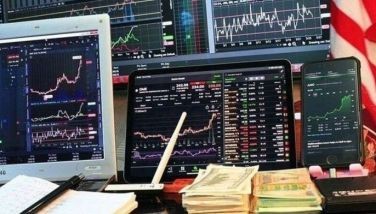Peso slumps to 50.50 against dollar
April 7, 2001 | 12:00am
Dragged down anew by the weakness of the Japanese yen and the Thai baht, the peso plunged to 50.50-to-a-dollar during midday trading yesterday at the Philippine Dealing System (PDS).
However, the peso managed to recover at the close, settling at 50.20 or slightly lower than Thursday’s close of 50.175 to the dollar.
Currency traders said the peso’s continued fall was still a result of the weakening of major regional currencies led by the Japanese yen and the Thai baht.
The yen was trading at 125.50 to 124.80 to $1 while the Thai baht was trading at 45.60 to 45.80 to the greenback.
The lack of fresh inflows also dragged down the peso, traders said, adding that they expect the peso to remain weak until after the May elections.
They said the uncertainty in the economic and political front in Japan is also expected to pull down the peso.
Also, the absence of fresh news that would stir up talks of a possible prevention of the anticipated economic downturn in the US is forcing investors and market players to hold on to their dollars.
Traders said the peso will continue to weaken and test the 50.30 psychological barrier by next week.
A trader from a foreign bank said oil importers and some foreign banks were seen bidding the dollar up in early trade but inflows from overseas workers ahead of a long weekend capped the peso’s downside.
Local oil companies are concerned that the continuing weakness of the peso might trigger an increase in the prices of petroleum products, a ranking oil firm official said.
In an interview, Petron Corp. chairman Jose Syjuco said a further drop in the peso’s value is bound to trigger price adjustments this, he said, is normal on a deregulated environment.
But, Syjuco said they still have to assess the situation before making any decision. "We are hoping that the situation stabilizes so that upward movement in local pricing may not be necessary," he said.
Oil majors have committed to keep pump prices stable until after the May elections this year.
The peso, however, has breached the P50-to-a-dollar level due to uncertainties in the international market as the US market weakens.
Consumer Oil and Price Watch (COPW) chairman Raul T. Concepcion said local oil prices would remain stable even if the peso reaches the 50-to-a-dollar level.
Concepcion said if the peso remains at P48.75 average this month, there is a possibility of a price rollback of 20 to 26 centavos by May. – Rocel Felix and Donnabelle Gatdula
However, the peso managed to recover at the close, settling at 50.20 or slightly lower than Thursday’s close of 50.175 to the dollar.
Currency traders said the peso’s continued fall was still a result of the weakening of major regional currencies led by the Japanese yen and the Thai baht.
The yen was trading at 125.50 to 124.80 to $1 while the Thai baht was trading at 45.60 to 45.80 to the greenback.
The lack of fresh inflows also dragged down the peso, traders said, adding that they expect the peso to remain weak until after the May elections.
They said the uncertainty in the economic and political front in Japan is also expected to pull down the peso.
Also, the absence of fresh news that would stir up talks of a possible prevention of the anticipated economic downturn in the US is forcing investors and market players to hold on to their dollars.
Traders said the peso will continue to weaken and test the 50.30 psychological barrier by next week.
A trader from a foreign bank said oil importers and some foreign banks were seen bidding the dollar up in early trade but inflows from overseas workers ahead of a long weekend capped the peso’s downside.
Local oil companies are concerned that the continuing weakness of the peso might trigger an increase in the prices of petroleum products, a ranking oil firm official said.
In an interview, Petron Corp. chairman Jose Syjuco said a further drop in the peso’s value is bound to trigger price adjustments this, he said, is normal on a deregulated environment.
But, Syjuco said they still have to assess the situation before making any decision. "We are hoping that the situation stabilizes so that upward movement in local pricing may not be necessary," he said.
Oil majors have committed to keep pump prices stable until after the May elections this year.
The peso, however, has breached the P50-to-a-dollar level due to uncertainties in the international market as the US market weakens.
Consumer Oil and Price Watch (COPW) chairman Raul T. Concepcion said local oil prices would remain stable even if the peso reaches the 50-to-a-dollar level.
Concepcion said if the peso remains at P48.75 average this month, there is a possibility of a price rollback of 20 to 26 centavos by May. – Rocel Felix and Donnabelle Gatdula
BrandSpace Articles
<
>
- Latest
- Trending
Trending
Latest
Trending
Latest
Recommended
January 10, 2025 - 12:00am




























